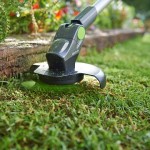One of the most versatile tools used for cutting a wide array of materials – everything from metal alloys like aluminium, steel and stainless steel, to concrete wood, stone and other materials is the angle grinder. This powerful cutting tool uses thin, round and flat panels like a DVD or CD, known as the grinding discs. They are typically categorised into diamond discs and classic cutting discs that utilise a synthetic resin as a binder.

Cutting discs are installed onto the grinder, and when used, it causes reduction in the total length of the product, unlike when cutting with scissors and a knife, in which case the cut parts are the same length when connected together. The process involves fast honing of material (of about 7-10 000RPM) on a pretty small area of about 0.8mm to 3mm. This is mainly because cutting with discs reduces material from a specific point to make a hole which is going to separate the project being cut into smaller pieces.
One thing to note is that this cutting method creates high amounts of friction that can develop high temperatures at the cutting point and cause unwanted changes in colour and structure. In the metalworking industry, angle grinding discs that are used most commonly are the classic ones that feature a synthetic resin as a binder. There are discs especially made for a specific purpose, and are separated by the type of material they cut, such as discs for cutting stone, aluminium, stainless steel and steel.
On the other hand, the diamond cutting discs are more expensive than the classic cutting discs because of their production technology using diamonds. They aren’t actually completely made of diamonds, but their edge is covered with small layer of diamond grains. These discs are typically used for cutting asphalt, concrete, stone and reinforced concrete, but thanks to advancements in technology, nowadays they are more affordable and their use has expanded to cutting plastic, steel, ceramic, etc…
Regardless of the type of angle grinding discs you’re going to buy, one of the most important factors to consider is the disc thickness. The disc thickness can impact the quality and speed of the cuts. Usually the thinner the disc – the more accurate and quick cuts you’re going to make, and the less material is going to be removed. On the other hand, thicker discs are usually cheaper and have a slightly longer life-span.


